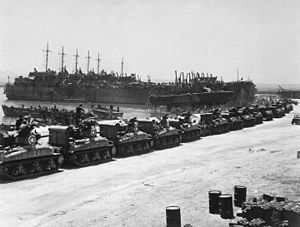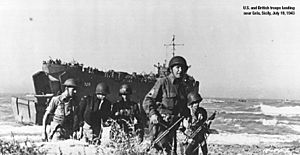Operation Husky order of battle facts for kids
Operation Husky order of battle lists the main military and air force groups that took part in the fight for Sicily. This important campaign happened from July 10 to August 17, 1943, during World War II. It shows how the Allied and Axis forces were set up for this big invasion.
Contents
- Allied Forces: The Attackers
- Axis Forces: The Defenders
- Images for kids
Allied Forces: The Attackers
The Allied forces were led by General Dwight D. Eisenhower, who was the Supreme Commander for the Mediterranean area.
Allied 15th Army Group: Ground Troops
The Allied 15th Army Group was commanded by General Sir Harold Alexander. This group included many different army divisions ready for battle.
- U.S. 9th Infantry Division
- Led by Major General Manton S. Eddy.
- Key units included the 39th, 47th, and 60th Infantry Regiments, along with various artillery, engineer, and anti-aircraft battalions.
- U.S. 82nd Airborne Division
- Commanded by Major General Matthew Ridgway. This division was known for its paratroopers and glider troops.
- Important units were the 504th and 505th Parachute Infantry Regiments, and the 325th Glider Infantry Regiment.
- 46th British Infantry Division
- Led by Major General H. A. Freeman-Attwood.
- Its main parts were the 128th, 138th, and 139th Infantry Brigades.
U.S. Seventh Army: American Power
The U.S. Seventh Army was under the command of Lieutenant General George S. Patton. This army had a mix of specialized units.
- Key units included the 1st, 3rd, and 4th Ranger Battalions, which were elite commando units.
- It also had several tank and tank destroyer battalions, engineer regiments, and artillery groups.
- The Free French 4th Moroccan Tabor also supported this army.
U.S. II Corps: Leading the Way
The U.S. II Corps was led by Lieutenant General Omar Bradley.
- U.S. 1st Infantry Division
- First led by Major General Terry Allen, then by Major General Clarence R. Huebner.
- Known for its 16th, 18th, and 26th Infantry Regiments.
- U.S. 45th Infantry Division
- Commanded by Major General Troy H. Middleton.
- Its main units were the 157th, 179th, and 180th Infantry Regiments.
U.S. Provisional Corps: Reinforcements Arrive
This corps was activated on July 15, 1943, and commanded by Major General Geoffrey Keyes.
- U.S. 2nd Armored Division
- Led by Major General Hugh Joseph Gaffey. This division had powerful tanks and armored infantry.
- U.S. 3rd Infantry Division
- Commanded by Major General Lucian Truscott.
- Its main infantry regiments were the 7th, 15th, and 30th.
British Eighth Army: Commonwealth Power
The British Eighth Army was commanded by General Sir Bernard Montgomery.
- Army Troops
- This included special forces like the 2nd Special Air Service and various Commando units.
- Other units were the 2nd/7th Battalion, Middlesex Regiment, and the 1st Battalion, Argyll and Sutherland Highlanders.
British XIII Corps: Key British Units
XIII Corps was led by Lieutenant-General Miles Dempsey.
- 5th Infantry Division
- Commanded by Major-General Horatio Berney-Ficklin.
- Its brigades included the 13th, 15th, and 17th Infantry Brigades.
- 50th (Northumbrian) Infantry Division
- Led by Major-General Sidney Kirkman.
- Key units were the 69th, 151st, and 168th Infantry Brigades.
- British 78th Infantry Division
- Commanded by Major-General Vyvyan Evelegh.
- Its brigades were the 11th, 36th, and 38th (Irish) Infantry Brigades.
- 1st Airborne Division
- Led by Major-General George F. Hopkinson. Parts of this unit were used in the invasion.
- British 4th Armoured Brigade
- This brigade included tank regiments like the 3rd County of London Yeomanry (Sharpshooters) and the 44th Royal Tank Regiment.
British XXX Corps: More Allied Strength
XXX Corps was commanded by Lieutenant-General Sir Oliver Leese.
- 1st Canadian Infantry Division
- Led by Major-General Guy Simonds.
- It had the 1st, 2nd, and 3rd Canadian Infantry Brigades.
- 1st Canadian Tank Brigade
- This brigade included the 11th, 12th, and 14th Army Tank Regiments.
- British 51st (Highland) Infantry Division
- Commanded by Major-General Douglas Wimberley.
- Its brigades were the 152nd, 153rd, and 154th Infantry Brigades.
- 23rd Armoured Brigade
- Included tank units like the 50th Royal Tank Regiment.
- British 231st Infantry Brigade
- Its main units were the 2nd Battalion, Devonshire Regiment, and the 1st Battalion, Dorsetshire Regiment.
The naval forces were led by Admiral of the Fleet Sir Andrew Browne Cunningham. They were split into different Task Forces to manage the huge invasion fleet.
- Covering Force
- Its job was to stop the Italian Navy from attacking the invasion ships.
- Eastern Naval Task Force
- This force carried the British Eighth Army and provided Naval gunfire support (shooting from ships to help troops on land).
- Western Naval Task Force
- This force carried the Seventh U.S. Army and also provided naval gunfire support.
- It included the 8th U.S. Amphibious Force, led by Admiral Henry Kent Hewitt. This force had several smaller task forces, each responsible for landing specific U.S. Army divisions.
Allied Air Forces: Control of the Skies
The Allied air forces in the Mediterranean were part of the Mediterranean Air Command (MAC), led by Air Chief Marshal Sir Arthur Tedder of the Royal Air Force.
- Northwest African Air Forces (NAAF)
- Led by Lt. General Carl Spaatz of the U.S. Army Air Forces.
- This was the main air command for the invasion.
- Northwest African Strategic Air Force
- Commanded by Maj. General James H. Doolittle. This force focused on long-range bombing.
- Northwest African Coastal Air Force
- Led by Air Vice-Marshal Sir Hugh Lloyd. This force protected the coasts and seas.
- Northwest African Tactical Air Force
- Commanded by Air Marshal Sir Arthur Coningham. This force provided close air support for ground troops.
- It included the Desert Air Force and the XII Air Support Command, which flew fighter and bomber planes like Spitfires, P-40 Warhawks, and A-36 Mustangs.
- Northwest African Troop Carrier Command
- Led by United States Paul Williams. This command was in charge of transporting troops and supplies by air, using planes like the C-47 Skytrain.
- Northwest African Photographic Reconnaissance Wing
- Commanded by Colonel Elliott Roosevelt. This unit flew planes like P-38 Lightnings to take pictures for intelligence.
- Air Headquarters Malta
- Led by Air Vice-Marshal Sir Keith Park. Air units from Malta also helped in the operation.
- RAF Gibraltar
- Commanded by Air Vice Marshal Sturley Simpson. This base provided air support and reconnaissance.
- 9th Air Force (U.S.)
- Led by Major General Lewis H. Brereton. This force included bomber groups with B-24 Liberators.
Axis Forces: The Defenders
The Axis forces on Sicily were under the Armed Forces Command Sicily, led by Generale d'Armata Alfredo Guzzoni.
Italian 6th Army: Italy's Ground Defense
The Royal Italian Army's 6th Army was also commanded by Generale d'Armata Alfredo Guzzoni. It included all Italian and German army units on Sicily.
- The 6th Army had many specialized units, including anti-tank groups with powerful self-propelled guns.
- It also had tank regiments with Fiat 3000 and R35 tanks.
- Over 100 "Anti-paratrooper units" were formed to search for Allied paratroopers and pilots behind the front lines.
Italian XII Army Corps: Western Sicily Defense
The XII Army Corps was responsible for the western part of Sicily.
- It included various artillery groups, anti-tank battalions, and engineer units.
- Coastal Troops Command managed several coastal divisions, like the 202nd, 207th, and 208th Coastal Divisions. These divisions were positioned along the coast to defend against landings.
- Tactical Groups and Mobile Groups were special battle groups created to quickly respond to Allied landings. They were made up of motorized units and tanks.
- The corps also had reserve divisions, including the 26th Infantry Division "Assietta" and the 28th Infantry Division "Aosta".
Italian XVI Army Corps: Eastern Sicily Defense
The XVI Army Corps was responsible for the eastern part of Sicily.
- It had its own artillery, engineer, and anti-aircraft units.
- Coastal Troops Command here managed divisions like the 206th and 213th Coastal Divisions, which defended the eastern and southern coasts.
- Similar to the XII Corps, it had Tactical Groups and Mobile Groups ready for quick responses.
- The corps' reserve included the 4th Infantry Division "Livorno" and the 54th Infantry Division "Napoli".
German XIV Panzer Corps: Elite German Units
The XIV Panzer Corps was formed on July 18, 1943, and commanded by General der Panzertruppe Hans-Valentin Hube. This corps brought powerful German divisions to Sicily.
- Panzer Division "Hermann Göring"
- This elite division had many tanks, including Panzer IIIs, Panzer IVs, and powerful Tiger I tanks.
- 15th Panzergrenadier Division
- This division had infantry and tank units, including Panzer IIIs and Panzer IVs.
- 1st Fallschirmjäger Division
- These highly trained paratroopers arrived by air to reinforce the defenses.
- 29th Panzergrenadier Division
- This division also arrived in Sicily starting July 18, bringing more infantry and StuG III assault guns.
Territorial Defense Command Palermo: Rear Area Security
This command was in charge of security behind the front lines, training new recruits, and forming new units. It included various military police, forestry, and local defense units.
The Royal Italian Navy's Maritime Military Command Sicily was based in Messina and led by Ammiraglio di Squadra Pietro Barone.
- Maritime Military Base Messina-Reggio Calabria
- This base protected the vital Strait of Messina with coastal regiments and artillery.
- Coastal Artillery Legions
- These units, like the 6th and 14th CC.NN. Maritime Artillery Legions, operated large coastal defense guns and anti-aircraft batteries to protect harbors and shorelines.
- Maritime Military Sector Augusta-Syracuse and Maritime Military Sector Trapani
- These sectors managed coastal defenses in other key harbor areas, with more coastal artillery and anti-aircraft guns.
- Armored Trains
- The Royal Italian Navy had 10 armored trains equipped with naval guns. However, due to Allied air superiority, they couldn't leave their shelters and were later destroyed by their crews.
Air Force Command Sicily: Axis Air Power
Airfields on Sicily were under the Royal Italian Air Force's Air Force Command Sicily, led by Generale di divisione aerea Adriano Monti.
- Each airfield had infantry and artillery for defense.
- Various fighter squadrons with planes like C.202 Folgore and Bf.109G were based at airfields like Castelvetrano Airfield, Chinisia Airfield, Comiso Airfield, and Sigonella Airfield.
- Bomber and torpedo-bomber squadrons with planes like SM.79 Sparviero were also present.
- The German Jagdgeschwader 53 and Schnellkampfgeschwader 10 also had fighter units on the island.
- The 3rd Air Fleet and 4th Air Fleet from mainland Italy also sent bombers and fighters to support the defense.
Territorial Anti-aircraft Defense: Protecting from the Sky
This organization was responsible for defending cities and military sites from air attacks. It managed many anti-aircraft batteries across Sicily, using guns of various sizes.
- Major cities and airfields like Catania, Gela, Palermo, and Trapani had numerous anti-aircraft batteries.
- These batteries used guns like the 90/53 and 20/65 to shoot down enemy planes.
Voluntary Militia for National Security: Fascist Support
The Voluntary Militia for National Security (MVSN) was the Italian Fascist Party's paramilitary group. They provided military units to support the Royal Italian Army and Navy.
- They formed various legions and battalions, like the 166th CC.NN. Legion "Peloro" and the 171st CC.NN. Legion "Vespri", which were assigned to different army and naval commands for defense.
Images for kids








